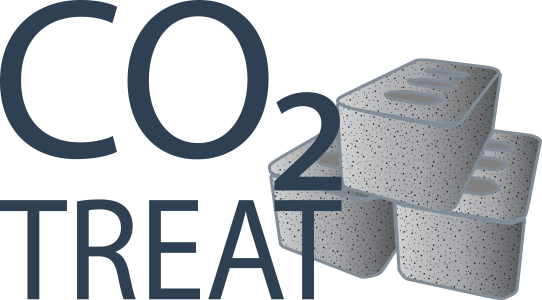The main aim of the CO2TREAT project is to design resource-efficient, low-carbon binder products for durable concrete and civil engineering applications by partially substituting Portland cement with secondary resources beneficiated by treatment with CO2. Considering circular design, the project targets to narrow material loops and increase resource-efficiency by substituting primary resources, scarce resources or products with a high carbon footprint by carbon-negative alternatives. The following specific objectives are defined to reach the project goal:
1.
Treatment with CO2 of 3 high-volume, alkaline industrial (BOF steel slag, lignite fly ash and co-combustion ash). The CO2 present in flue gases or atmospheric CO2 is converted into thermodynamically stable mineral carbonate products.
2.
Recovery of metallic iron from BOF steel slags by comminution and physical separation.
3.
Design of sustainable binders that comprise the CO2-treated materials and comply to stringent performance and durability standards for cement, concrete and civil works. The binders will be characterised and their hydration processes will be modeled.
4.
Quantification of the sustainability of the use of the CO2-beneficiated materials in low-carbon cement, concrete and civil works by a Techno-Economic Analysis (TEA) and Life Cycle Analysis (LCA).
CO2TREAT aims to provide negative or low carbon secondary resources for the production of a new generation of sustainable binders and concrete or geotechnical civil works made thereof. The project anticipates to open new recycling opportunities for large volumes of alkaline mineral residues by CO2 beneficiation.
Compared to the annual European cement production of 170 Mt including 38 Mt of SCMs, CO2TREAT, if realised to its maximal extent, could almost double the amount of SCMs available for composite cement production and help to reduce clinker contents and direct CO2 emissions by an additional 20% or 30 Mt CO2/y.
The CO2 beneficiation processes proposed by CO2TREAT would enable an additional CO2 sequestration of 50-200 kg/t steel slag or 25-90 kg/t lignite and co-combustion fly ashes. Combining average values for the reported CO2 uptake ranges with the potentially available materials in Europe, returns a potential gross impact of 2.7 Mt/y of CO2 bound into stable mineral carbonates.
The net CO2 reductions taking into account the energy needed for the beneficiation treatments as well as other environmental benefits from reducing mining of primary resources will be calculated by LCA.
